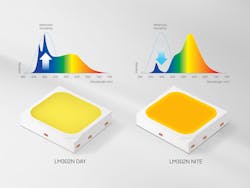Packaged LED news: Samsung HCL LEDs and Crystal IS UV LEDs
Application-specificity in packaged LEDs continues to be a trend in the component sector, and both Samsung and Crystal IS have pushed that trend along with their latest components. Samsung has announced what it called “human-centric LED packages” that come in versions with either enhanced or depleted energy in the blue or cyan region of the spectral power distribution (SPD). Meanwhile, Crystal IS has a new version of its ultraviolet (UV) LED that increases output power by 20% while also lowering cost, enabling broader use in solid-state lighting (SSL) sterilization.
Samsung LM302N
The new Samsung LEDs extend the portfolio of LEDs in the LM30x family — Samsung’s mid-power workhorse series of LEDs with 3×3-mm footprint. The LEDs are among the highest-performing mid-power components on the market, and Samsung has also delivered components in the portfolio for vertical applications such as horticultural lighting
We first saw a demonstration of the LM302N LEDs almost one year ago at LightFair International (LFI). At that time the company only had the version with enhanced blue spectrum but since has added the version with the depleted blue. The idea is that lighting manufacturers could make lamps or luminaires just for morning/day use and others just for evening/night use. Or the manufacturers could deliver a two-channel tunable system.
“The benefits of using Samsung’s LM302N reach beyond the basic lighting function of visual recognition, by improving the non-visual biological effects of lighting on people,” said Un Soo Kim, senior vice president of the LED Business Team at Samsung Electronics. “Our LED solutions are ushering in a whole new human-oriented approach of using artificial lighting to enhance productivity and relaxation, benefiting modern-day indoor lifestyles.”
The nearby image depicts the LEDs and the SPD graphs of each version. You can easily distinguish the two because of the phosphor color on the package. But the real detail is in the SPD graphs.
As we covered last year after LFI, Samsung is using dual blue emitters or pumps in the daytime version (LM302N DAY) of the LEDs. The dual emitters enables a broader spread of blue energy and greater impact on the nonvisual system without an excessively high blue peak using one pump. Moreover, the two emitters used together can be driven at lower current levels thus improving efficacy. Dual pumps in an LED were first shown at LEDucation 2019 by Bridgelux.
The night version of the LED (LM302N NITE) only has one blue peak at around the 440-nm wavelength. Samsung has played some other trick to keep the blue peak low while raising energy in the green, yellow, and red bands. The architecture could use additional phosphor to block some of the blue energy, or perhaps there is again some sort of dual-pump approach in play with the second pump in the yellow/orange region.
Klaran UV-C LED
“The completed production and technology improvements fulfill the promise of Crystal IS’ proprietary aluminum nitride substrates; high yields of high-output devices at deep-UV wavelengths” said Eoin Connolly, vice president of product management at Crystal. “Klaran continues to focus and achieve key milestones which allow us to deliver the products, performance, and price needed to meet the needs of global germicidal markets. Our rigorous testing, in-house microbiological facilities and ISO 9001:2015 quality system provide the data-driven proof of the reliability, performance, and efficacy of our products.”
The company now has a component that delivers 70 mW of radiant power in production. And an 80-mW component is available as engineering samples. Crystal said prices will be less than $0.15/mW. In this time of the coronavirus pandemic, such UV-C LEDs could come in handy in many facilities, as we have mentioned in a recent blog discussion on the potential for increased attention on the disinfection and sanitization market niche.

Maury Wright | Editor in Chief
Maury Wright is an electronics engineer turned technology journalist, who has focused specifically on the LED & Lighting industry for the past decade. Wright first wrote for LEDs Magazine as a contractor in 2010, and took over as Editor-in-Chief in 2012. He has broad experience in technology areas ranging from microprocessors to digital media to wireless networks that he gained over 30 years in the trade press. Wright has experience running global editorial operations, such as during his tenure as worldwide editorial director of EDN Magazine, and has been instrumental in launching publication websites going back to the earliest days of the Internet. Wright has won numerous industry awards, including multiple ASBPE national awards for B2B journalism excellence, and has received finalist recognition for LEDs Magazine in the FOLIO Eddie Awards. He received a BS in electrical engineering from Auburn University.






